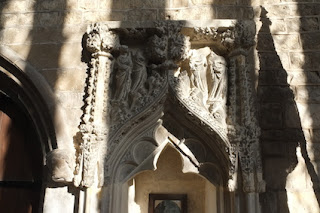Navenby, Lincolnshire
Top Dec.
Seen from across neighbouring gardens, the church almost disappears behind greenery. But the east window still stands out, and I think: ‘Yes! More glorious Lincolnshire tracery.’
Lincolnshire is a county full of churches with elaborate curvaceous 14th-century window tracery. At big parish churches like the ones at Sleaford, Grantham, and Heckington, the tracery curves this way and that in a series of patterns of sometimes dizzying complexity and variety – curvilinear tracery of the most inventive kind. This is a smaller church, but the east window is as wonderful as those of its larger cousins. The tracery pattern here is dominated by two mouchettes – the shapes that look like gigantic skewed commas, their tails pointing down and outwards, their heads nodding towards each other and touching at the centre. Within each mouchette are other shapes – large multi-cusped trefoils in the heads, elongated ‘daggers’ in the tails.
This is all very showy and was designed to hold stained glass which has not survived. The glass is clear now, so the sunlight pours into the chancel, as it was doing on the day I visited recently. And what the light falls on is equally remarkable: a series of niches, sedilia, and a piscina, all surrounded and topped with highly ornate 14th-century carving. Pinnacles, crockets, foliage, figures, human heads – this carving has the lot. A high-class carver has been here and has thrown the kitchen sink at this job. You can see why this style was labelled Decorated Gothic (often abbreviated to ‘Dec.’) in the 19th century.
The niche to the right of the door is what eccesiologists used to call an Easter Sepulchre, which was thought to be a niche used in an Easter ritual in which the Crucifixion and Resurrection were symbolically re-enacted by ‘entombing’ a cross in the niche and removing it on Easter Day. Historians now question this, suggesting that niches like this were more likely used all year round for reserving the consecrated bread and wine. The imagery is certainly linked to the Resurrection – three Maries at the top with an angel, the Roman soldiers at the base. Whichever it is, the the carving is outstanding – it’s suggested that it was done at the behest of William de Herleston, who was rector here in the 1320s and was closely connected to the royal court. I can well believe that this work had such a high-status patron.






Comments
Post a Comment